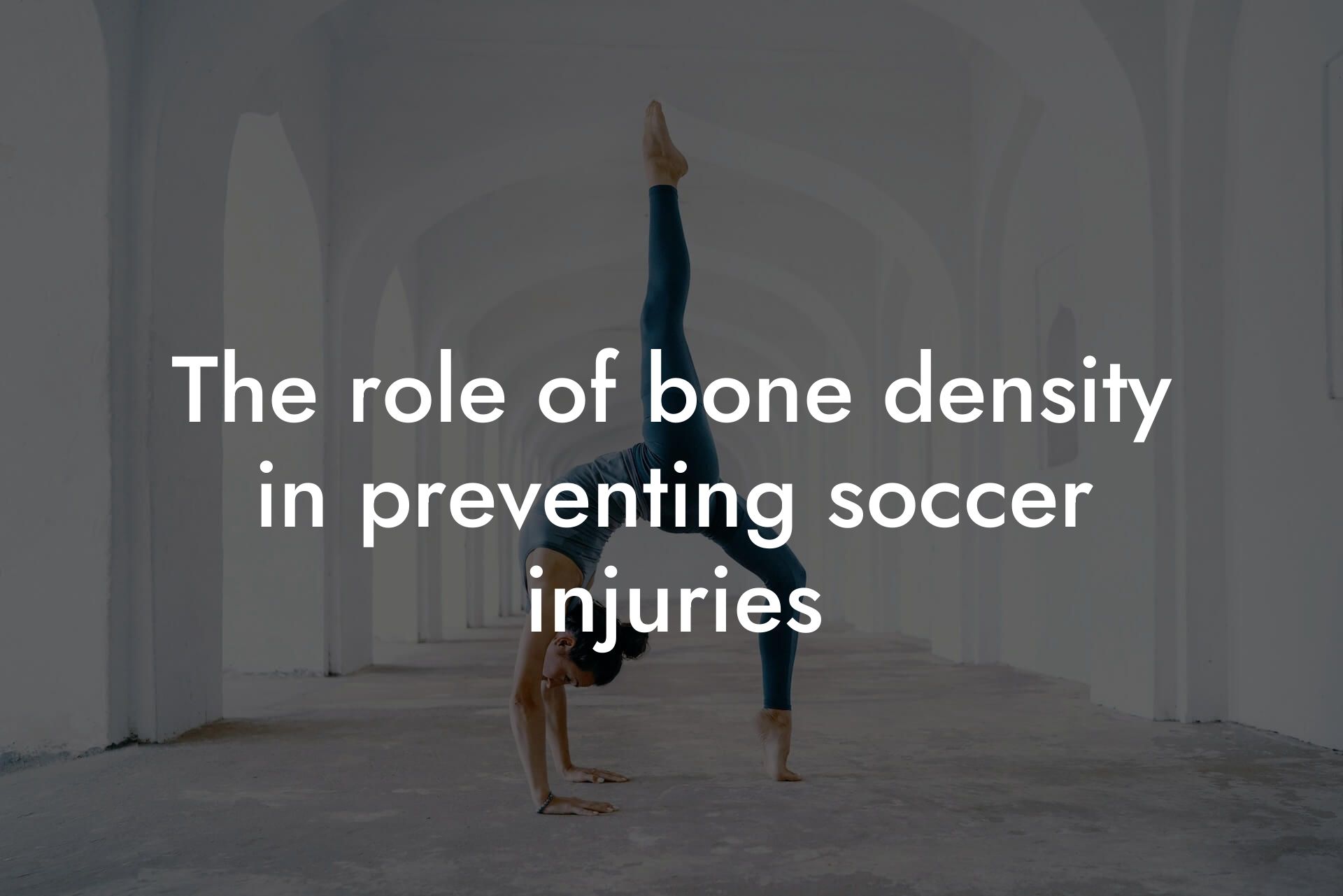Introduction
As a high-earning professional, you understand the importance of physical fitness in maintaining a healthy and successful lifestyle. For soccer players, achieving a balance between endurance and strength is crucial for optimal performance on the field. In this article, we'll delve into the importance of balancing endurance and strength in soccer, and provide you with practical tips and strategies to improve your game.
Table of Contents
- Introduction
- Why Endurance Matters in Soccer
- The Importance of Strength in Soccer
- The Consequences of Imbalance
- Assessing Your Current Level of Endurance and Strength
- Training Strategies for Improving Endurance
- Training Strategies for Improving Strength
- Periodization and Progressive Overload
- Frequently Asked Questions
Why Endurance Matters in Soccer
Endurance is the ability to sustain a high level of intensity over a prolonged period. In soccer, endurance is essential for covering the vast distances required during a match, which can range from 7-13 kilometers. A player with high endurance can maintain a high work rate, making them more effective in both offense and defense. Endurance also enables players to recover quickly between plays, allowing them to perform at a higher level throughout the game.
The Importance of Strength in Soccer
Strength is the ability to generate force against an external resistance. In soccer, strength is critical for explosive movements, such as sprinting, jumping, and changing direction quickly. A strong player can also hold their own against opponents, win headers, and shoot with power and accuracy. Furthermore, strength helps to reduce the risk of injury, as a stronger muscle can absorb and distribute the forces generated during play.
The Consequences of Imbalance
If a player focuses too much on endurance, they may sacrifice strength, leading to a lack of power and explosiveness. On the other hand, if a player prioritizes strength, they may neglect their endurance, resulting in fatigue and decreased performance over time. An imbalance between endurance and strength can also lead to injuries, as the body is subjected to excessive stress and strain.
Assessing Your Current Level of Endurance and Strength
To achieve a balance between endurance and strength, it's essential to assess your current level of fitness. At Tano Performance Group, we use a DEXA machine to provide a comprehensive body assessment, including measurements of body fat, muscle mass, and bone density. This information allows us to create a personalized training program tailored to your specific needs and goals.
Training Strategies for Improving Endurance
To improve endurance, incorporate the following training strategies into your routine:
Aerobic exercises, such as jogging, cycling, or swimming, to improve cardiovascular fitness.
High-intensity interval training (HIIT) to simulate the demands of a soccer match.
Strength training exercises that target the legs, core, and glutes, such as squats, lunges, and deadlifts.
Plyometric exercises, such as jump squats and box jumps, to improve power and explosiveness.
Training Strategies for Improving Strength
To improve strength, focus on the following training strategies:
Resistance training exercises, such as weightlifting, to build muscle mass and strength.
Explosive training exercises, such as box jumps and depth jumps, to improve power and acceleration.
Functional training exercises, such as agility drills and plyometric exercises, to improve speed, agility, and quickness.
Core strengthening exercises, such as planks and Russian twists, to improve stability and balance.
Periodization and Progressive Overload
To achieve a balance between endurance and strength, it's essential to periodize your training and incorporate progressive overload. Periodization involves dividing your training into specific phases, each with a focus on either endurance or strength. Progressive overload involves gradually increasing the intensity of your training over time, to continue challenging your body and promoting adaptation.
In conclusion, balancing endurance and strength is critical for optimal performance in soccer. By understanding the importance of both endurance and strength, assessing your current level of fitness, and incorporating specific training strategies into your routine, you can improve your overall performance and gain a competitive edge. Remember to periodize your training and incorporate progressive overload to continue challenging your body and promoting adaptation. With dedication and hard work, you can achieve a balance between endurance and strength, and take your game to the next level.
Frequently Asked Questions
What is the importance of balancing endurance and strength in soccer?
Balancing endurance and strength is crucial in soccer as it enables players to maintain a high level of performance throughout the game. Endurance helps players to sustain their energy levels, while strength enables them to explosively accelerate, decelerate, and change direction quickly. A balance between the two allows players to excel in both aerobic and anaerobic aspects of the game.
How does endurance benefit soccer players?
Endurance is essential for soccer players as it allows them to maintain a high intensity of play throughout the game. It enables players to recover quickly between sprints, maintain their speed and agility, and reduce their risk of injury. Good endurance also enables players to concentrate and make better decisions during the game.
What are the benefits of strength training for soccer players?
Strength training is vital for soccer players as it improves their power, speed, and acceleration. It also enhances their ability to shoot, pass, and head the ball with precision and force. Additionally, strength training helps players to maintain their position and win battles against opponents, reducing their risk of injury.
How can soccer players improve their endurance?
Soccer players can improve their endurance through aerobic exercises such as jogging, cycling, and swimming. They can also incorporate high-intensity interval training (HIIT) into their workouts, which involves short bursts of intense exercise followed by brief periods of rest. Players should also focus on building their cardiovascular endurance through exercises that target their heart rate and lung function.
What are some effective strength training exercises for soccer players?
Effective strength training exercises for soccer players include squats, lunges, deadlifts, and leg press. These exercises target the legs, glutes, and core muscles, which are essential for power, speed, and agility. Players should also incorporate plyometric exercises such as jump squats and box jumps to improve their explosiveness.
How often should soccer players train for endurance and strength?
Soccer players should aim to train for endurance and strength at least 2-3 times per week, with at least one day of rest in between. They should also incorporate active recovery techniques such as stretching, foam rolling, and light cardio to aid in their recovery.
Can endurance and strength training be done simultaneously?
Yes, endurance and strength training can be done simultaneously. In fact, concurrent training is a common practice among soccer players. This involves incorporating both endurance and strength exercises into a single workout, or alternating between the two on different days.
How can soccer players balance their endurance and strength training?
Soccer players can balance their endurance and strength training by allocating specific days for each type of training. For example, they can dedicate Mondays and Wednesdays to endurance training, and Tuesdays and Thursdays to strength training. They should also prioritize their training based on their goals and the demands of the game.
What is the role of nutrition in balancing endurance and strength in soccer?
Nutrition plays a critical role in balancing endurance and strength in soccer. Players should focus on consuming a balanced diet that includes complex carbohydrates, lean proteins, and healthy fats. They should also stay hydrated by drinking plenty of water before, during, and after training and competition.
How can soccer players monitor their endurance and strength progress?
Soccer players can monitor their endurance and strength progress through various methods such as heart rate monitoring, GPS tracking, and strength testing. They can also use subjective measures such as rating of perceived exertion (RPE) and self-reported fatigue levels.
What are some common mistakes soccer players make when training for endurance and strength?
Common mistakes soccer players make when training for endurance and strength include overtraining, inadequate recovery, and poor nutrition. They may also neglect to incorporate specific exercises that target their weaknesses, or fail to periodize their training to avoid plateaus.
How can soccer players incorporate agility and speed training into their endurance and strength workouts?
Soccer players can incorporate agility and speed training into their endurance and strength workouts by adding exercises that target their acceleration, deceleration, and change of direction. Examples include shuttle runs, cone drills, and resistance band training.
What is the importance of flexibility and mobility in balancing endurance and strength in soccer?
Flexibility and mobility are essential in balancing endurance and strength in soccer as they enable players to move efficiently and effectively. Good flexibility and mobility also reduce the risk of injury and improve overall performance.
How can soccer players improve their flexibility and mobility?
Soccer players can improve their flexibility and mobility through stretching exercises, foam rolling, and self-myofascial release. They should also incorporate dynamic movements such as leg swings, high knees, and lunges into their warm-ups and cool-downs.
What is the role of rest and recovery in balancing endurance and strength in soccer?
Rest and recovery are critical components of balancing endurance and strength in soccer. Adequate rest and recovery enable players to repair and adapt to the physical demands of the game, reducing their risk of injury and improving their overall performance.
How can soccer players optimize their rest and recovery?
Soccer players can optimize their rest and recovery by getting adequate sleep, incorporating active recovery techniques such as stretching and foam rolling, and using recovery tools such as compression garments and ice baths.
What are some common injuries associated with endurance and strength training in soccer?
Common injuries associated with endurance and strength training in soccer include muscle strains, tendonitis, and overuse injuries such as shin splints and plantar fasciitis. Players should take proactive measures to prevent these injuries by incorporating injury prevention exercises and stretching into their training.
How can soccer players prevent injuries during endurance and strength training?
Soccer players can prevent injuries during endurance and strength training by incorporating injury prevention exercises, warming up and cooling down properly, and listening to their bodies and taking regular breaks. They should also focus on building their strength and endurance gradually, rather than trying to do too much too soon.
What is the importance of mental preparation in balancing endurance and strength in soccer?
Mental preparation is essential in balancing endurance and strength in soccer as it enables players to stay focused, motivated, and composed under pressure. Good mental preparation also helps players to overcome fatigue and push themselves to their limits.
How can soccer players improve their mental preparation?
Soccer players can improve their mental preparation through techniques such as visualization, positive self-talk, and mindfulness meditation. They should also focus on building their confidence and self-belief, and developing a growth mindset that enables them to learn from their mistakes.
What is the role of a coach or trainer in balancing endurance and strength in soccer?
A coach or trainer plays a critical role in balancing endurance and strength in soccer by designing and implementing training programs that meet the specific needs of each player. They should also provide guidance on nutrition, recovery, and mental preparation, and offer support and feedback to help players optimize their performance.
How can soccer players continue to improve their endurance and strength over time?
Soccer players can continue to improve their endurance and strength over time by setting specific goals, tracking their progress, and making adjustments to their training programs as needed. They should also stay committed to their training, and be willing to try new exercises and techniques to continue challenging themselves.
What is the importance of balancing endurance and strength in soccer for overall health and well-being?
Balancing endurance and strength in soccer is essential for overall health and well-being as it enables players to maintain a healthy weight, reduce their risk of chronic diseases, and improve their mental health and mood. Good endurance and strength also enhance overall physical function, reducing the risk of injury and improving quality of life.
Here are some related articles you might love...
- Off-season training strategies for soccer players
- Using DEXA scans to monitor soccer player health and performance
- The role of bone density in preventing soccer injuries
- Reducing body fat to enhance soccer agility
- Hydration and recovery tips for soccer athletes
- Nutrition tips for maintaining energy levels during soccer matches
- How body composition affects speed and stamina in soccer
- Maintaining lean muscle mass for optimal soccer performance
- Strength and conditioning programs for soccer players
Zak Faulkner
Zak Faulkner is a leading authority in the realm of physical health and body composition analysis, with over 15 years of experience helping professionals optimise their fitness and well-being. As one the experts behind Tano Performance Group, Zak has dedicated his career to providing in-depth, science-backed insights that empower clients to elevate their physical performance and overall health.
With extensive knowledge of DEXA technology, Zak specializes in delivering comprehensive body assessments that offer precise data on body fat, muscle mass, bone density, and overall physique. His expertise enables individuals to make informed decisions and achieve their fitness goals with accuracy and confidence. Zak’s approach is rooted in a deep understanding of human physiology, combined with a passion for helping clients unlock their full potential through personalised strategies.
Over the years, Zak has earned a reputation for his commitment to excellence, precision, and client-focused service. His guidance is trusted by top professionals who demand the best when it comes to their health. Whether advising on fitness programs, nutritional strategies, or long-term wellness plans, Zak Faulkner’s insights are a valuable resource for anyone serious about taking their health and fitness to the next level.
At Tano Performance Group, Zak continues to lead our Content Team revolutionising how professionals approach their physical health, offering unparalleled expertise that drives real results.




